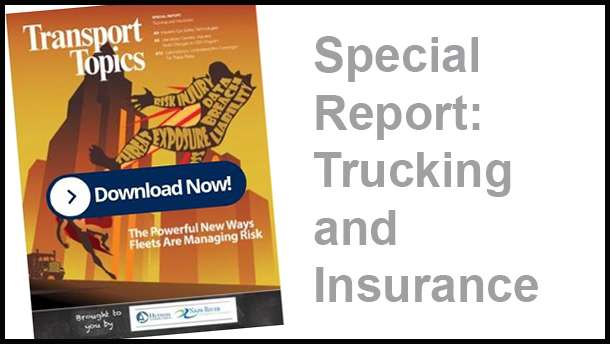Features Editor
Insurers Eye Safety Technologies

[Stay on top of transportation news: Get TTNews in your inbox.]
As the trucking industry grapples with a litigious environment and many motor carriers struggle to manage ever-rising insurance premiums, safety technologies have captured the attention of the insurance industry. Collision mitigation systems, telematics and onboard cameras can help fleets reduce or possibly eliminate costly and catastrophic losses, industry representatives said.
Rates and premiums for commercial auto liability insurance policies continue to rise, as they have been for the past several years, said Todd Reiser, vice president of the transportation practice at insurance broker Lockton Cos. Pricing is based on individual company loss experience as well as general industry trends and actuarial analysis, he noted. “Rate increases have ranged from single digits to, in some cases, double or worse depending on these factors.”
And the excess liability insurance market, Reiser said, “is in worse shape than the primary layer market, and is experiencing substantial rate increases combined with significant reductions in available capacity.”
“In the past six months, many excess insurers have exited the space altogether,” he said.
A fleet executive offered her take.
“Prices are driving up,” said Sherri Garner Brumbaugh, CEO of Findlay, Ohio-based Garner Trucking Inc. “If there aren’t choices or multiple insurers in the space of commercial auto liability, there are fewer to choose from and those left in the space take on the burden of risk and their costs go up, so that cost is going to affect premiums,” she said.
Meanwhile, an insurance company executive said trucking-related litigation has worsened, especially over the past three years.
“Nuclear verdicts, defined as jury awards in excess of $10 million, are becoming more prevalent, especially in the trucking world where higher liability limits are often purchased,” said Randy Ramczyk, director of underwriting for transportation at Sentry Insurance. “Plaintiff attorneys are now engaging in litigation financing where an unrelated third party provides financing to the plaintiff in litigation in return for a portion of any financial recovery from the lawsuit.”

Garner Brumbaugh
Garner Brumbaugh, who is second vice chairman of American Trucking Associations, agreed, noting trucking companies are going out of business “because of very aggressive trial lawyers.”
James Burg, president of Warren, Mich.-based James Burg Trucking Co. and chairman of the insurance task force for ATA, said a key focus is on nuclear verdicts and “suspicious activities” by certain attorney groups and medical providers in the same area.
Reiser said the maximum amount of coverage that a primary liability policy covers before excess coverage kicks in is $5 million, and it varies downward. Some fleets, including many smaller ones, are buying a primary policy with minimum limits, either $750,000 or $1 million. Large fleets generally are buying a primary policy that offers higher limits, usually up to $5 million, he said.
Garner Brumbaugh, though, said she hasn’t been in the “open” insurance market since 2001 because she essentially has been her own insurance company through a captive since then. In a captive, members surround themselves with peers who believe that “safety and a culture of safety is important,” Garner Brumbaugh said of this type of alternative risk program.
“Captives are and should be selective on the carriers they accept into any given group,” she said.
When it comes to safety, technologies such as collision mitigation and avoidance systems, as well as onboard cameras and telematics, now are squarely in the sights of the insurance industry.
Both primary liability underwriters and excess liability underwriters understand that safety technologies will have a major effect to help reduce catastrophic losses, noting underwriters are “under a ton of pressure” to be profitable, Reiser said.
“It is difficult to measure the exact impact of accidents that have either not happened at all or have been substantially mitigated by these technologies, especially for fleets that are largely self-insured,” Reiser said. He added that many large motor carriers now can point to their own safety data that show “a significant drop” in rear-end collisions for trucks equipped with collision mitigation systems.
Regardless of size, the key issues are reducing costs and returning drivers home to their families, said Craig Dancer, transportation industry practice leader at insurance broker Marsh USA Inc. That comes with having a safer operation.
“If you don’t have claims, your insurance costs come down and you avoid driver injuries,” Dancer said.
Peggy Killeen, director at Napa River Insurance Services, the third-party administrator for Hudson Insurance Group, said that pertaining to training, driver-facing cameras “have proven to be a very reliable tool for pre-emptively correcting less than safe behaviors and helping to avoid accidents.”
Cameras can help to monitor and improve driver behavior, Reiser said.
“When drivers know a camera is in the cab, they know whatever they do could potentially be reviewed,” he said, noting they also can potentially exonerate a fleet from liability.
Cameras can help to determine who may be at fault in a collision “and, in today’s litigious society, that can prove to be a game changer,” Sentry’s Ramczyk said.
Bill Zenk, principal and practice leader at insurance broker TrueNorth Cos., said the various safety technologies are creating an opportunity for motor carriers to collect data from in the cab “to coach better driver behavior as well as point-of-contact data to mitigate the cost of an accident.”
“We have seen a high correlation between implementing safety technology and reducing the number and severity of accidents,” Napa River’s Killeen said. “Specifically, vehicles equipped with crash avoidance systems have shown to be a valuable resource as it relates to lane change and merging accidents.”
Some insurers have established a prerequisite, Marsh’s Dancer said. This means they will consider a risk only if that risk uses a particular technology, such as collision avoidance, telematics devices or camera systems, he said, noting this has been more risk-specific than “a carte blanche approach.”
Electronic logging devices have been federally mandated since December 2017, Dancer added. If a carrier is not running ELDs in its trucks, aside from the allowed exceptions, “it’s doubtful that an insurer would agree to write that risk knowing a motor carrier was intentionally violating the mandate.”
Garner Brumbaugh said she believes ELDs will make the industry safer “especially when the industry is fully implemented in December 2019.”
“The challenges will be the learning curve, which takes time after full implementation. Many, like Garner, have made the full conversion to ELDs in advance of the implementation mandate,” she said, noting that Garner Trucking was an early adopter of electronic logs in 2010.
Meanwhile, Sentry’s Ramczyk said that besides in-cab camera systems, advanced collision mitigation systems, which are becoming standard on many new trucks, are effective.
“Rear-end collisions along with lane-change accidents are the most frequent and severe causes of loss in the trucking industry,” he said. “This technology can help to eliminate, reduce or alleviate these types of losses that can result in significant bodily injury or death.”
Ramczyk said he hasn’t seen any studies to verify this, “but common sense would dictate that technology can and will help minimize the number of commercial trucking accidents.”
Rather than providing discounts for using a specific technology, Marsh’s Dancer said, some insurers are subsidizing or paying for the hardware to install in the vehicles, citing camera systems as an example. “The insurer is betting that their investment in safety technology will be paid back over time based on their insured’s improved loss experience.”
Garner Trucking’s latest equipment purchases have safety technologies, including lane departure systems, crash avoidance, cameras and driver assist, Garner Brumbaugh said. “Do I get a break on my insurance premium for these voluntary purchases? No. Will they help a driver stay safe operating his/her truck? That is the objective, safety. But it takes time to cycle these trucks with these new safety technologies into operation.”
Premiums have increased industrywide over the past couple of years “and will continue to do so until loss costs stabilize,” Ramczyk said, noting that distracted driving, congested and deteriorating highways, rising medical costs and inexperienced drivers also are factors driving up insurance costs.
Insurance underwriters, meanwhile, want to understand the type of telematics a fleet is using, such as the record of critical events, Dancer said. “Even though you don’t have accidents, if you have a lot of critical events, those are indications of unsafe driving.”
A critical event record generally is integrated with a telematics device that can measure speed, hard braking and lane departures, among other factors, Dancer said.
“The key to implementing any technology is the follow-on coaching with a driver when critical events occur,” Dancer said. “Between ELDs, vehicle telematics and camera systems, motor carriers have tremendous amounts of data to identify at-risk behaviors allowing the motor carrier to act before an accident.”
Aside from the technology, the insurance industry representatives offered some tips for motor carriers to try to manage their insurance costs in the current challenging environment.
Fleets are changing how they finance their risk via alternative structures such as captives and aggregated insurance programs, as well as looking at taking on more risk, Reiser said.
“As costs continue to increase, only the most financially stable carriers will see value in continuing to buy high levels of excess insurance, as they have substantial assets to protect,” Reiser said.
Killeen, of Napa River Insurance, said motor carriers can elect to partner in the risk with an insurer by implementing a self-insured retention.
“A true SIR offers the motor carrier the benefit of providing input over claim settlement practices,” Killeen said, noting this is different from a deductible.
“They can either manage these claims on their own, or utilize a third-party administrator that has the expertise in claim expenses and litigation management,” she said, adding that these practices can lower costs and potentially reduce future premiums.
As for smaller motor carriers in particular, another trucking industry expert described a bleak predicament.
These carriers often lack the financial resources or a good loss history to access the alternative-risk market, such as captive insurance arrangements or higher deductible options, said Sam Tucker, CEO of Carrier Risk Solutions, which provides safety and compliance services to motor carriers. Smaller carriers generally can’t pass those increased insurance costs on to their shippers, he said, noting that ultimately, many carriers go out of business as a result.
WANT MORE NEWS? Listen to today's Daily Briefing
Looking ahead, TrueNorth’s Zenk said that a few insurers are offering motor carriers discounts “for simply exposing” the ELD data to the insurer.
“I believe the insurers are still determining how to most effectively use the data to better underwrite a motor carrier and move to usage/performance-based pricing,” Zenk said.
Nevertheless, with the continued increases in jury verdicts against trucking companies, increased medical costs, increased costs to repair damaged cars and trucks, among other factors, “We’re really looking at the perfect storm for these trends to continue for the foreseeable future,” Tucker said.





